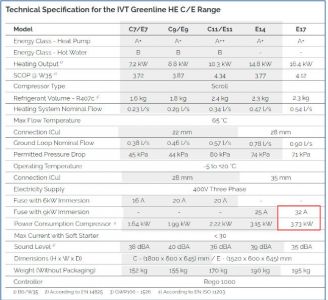GSHP for new-buid house with UFH - But what about DHW?
Hi there,
I am half-way through the build of a 550m2 house which has UFH throughout, no radiators. Heating is via a 17kW GSHP.
My question is - how best to heat the domestic hot water? If I run the heat pump at 30 degrees for the UFH and maximum efficiency, will I need to rely on an immersion heater for getting the DHW up to 55 deg? Alternatively if I run the heat pump at 50 degrees, then I need to waste power reducing this for the UFH. What is the best approach?
On a related ponit - the heat pump manufacturer has specced a large buffer tank (700 litre?) adjacent to the heat pump. Is this really necessary? The UFH circuits will provide sufficient load all the time to stop the heat pump short cycling, so I don't see why a buffer tank is required.
Any advice welcome...
Greetings, and welcome.
1: I'm unsure why you'd want 50°C to supply DHW.
If I buy a mixer-valve to protect against the danger of sending scalding water to a bath, then the usual default setting is for it to deliver 42°C at its output port. You can then change this, typically plus/minus 8°C by using a screwdriver, but few people do.
Equally, the default setting for output from a mixer-bar shower is 38°C.
You then press a button if you want to move the knob to a higher temperature.
Personally I prefer 36°C.
So if you're considering 50°C output for GSHP, then you must have a pretty inefficient cylinder/thermal store to deliver the DHW !
2: If your HP manufacturer is planning on a whopping 700-l buffer, then I'll suggest that the 17kW GSHP is rated too high!
The buffer tank is a fudge to help cool the water sufficiently before it returns to the heat-pump.
You need a less powerful heat-pump.
It it already installed?
Others are about to join in here and comment. Who's around? - @allyfish ? @kenbone ?
They will no doubt be asking for your GSHP model number and the heat-loss calculations for the amazing 550m² house. 😎
So you have a little while to scuttle around and find that info!
Save energy... recycle electrons!
@transparent Many thanks for this - I understand your comments re. the hot water temp. Let's say I run the DHW at 42c, this still too hot for the UFH system so the question is whether to use the heat pump JUST for the UFH at 30c (or thereabouts) and have the DHW on a completely separate system and heated via immersion?
The heat pump does not provide CH and DHW heating at the same time, there should be a diverter valve installed. The heat pump would then run at lower temperatures and more efficiently when supplying the UFH and at higher temperatures and lower efficiency when heating the DHW. Once per week it may be necessary to heat the DHW to 60C using the immersion heater for the final say 50C to 60C. You could also consider DHW heating by a solar PV system for much of the year.
Is the 700 litre tank actually a buffer or a thermal store?
It is possible that because of the size of your home you will require several zones and several water pumps, which may be one reason why a buffer tank has been specified. Having a buffer tank within an heat pump system is not always the most ideal, it will require careful commissioning and control.
@derek-m Thanks, that makes a lot of sense. The overall design for this system has been done by the heat pump manufacturer and I'm just trying to get my head around how it is supposed to work with optimum efficiency.
Then please keep asking the questions, however naive you think they might be!
I'm intrigued by some of what you say:
Why is the UFH required to receive water at 30°C?
- Is that a 'design temperature' dictated by the HP manufacturer?
- Or is it that the floor surface is made of something exotic which deforms at 36°C ? 🤔
Is this majestic 17Kw GSHP a single-phase unit?
And, if so, then how did you manage to get consent from your Distribution Network Operator (DNO) to have it installed?
Oh.... and we absolutely love photos 😉
Save energy... recycle electrons!
Posted by: @mch@derek-m Thanks, that makes a lot of sense. The overall design for this system has been done by the heat pump manufacturer and I'm just trying to get my head around how it is supposed to work with optimum efficiency.
I would suggest that you ask the system designer for a schematic diagram detailing the system layout and details of all the major components.
If you then require any clarification, forum members will be happy to advise.
@transparent The flooring in the house is a mixture of ceramic tile and engineered oak planks. I believe the specified max working temp for the flooring is 30c (or thereabouts), but I need to check.
The heat pump is 3-phase, and this whole discussion came about because the M&E people say we are maxing out the 3-phase 100A supply. My assumption is that the 17kW figure is the heat output NOT the electricity input; Therefore at a COP of 4.0 the electricity demand from the heat pump shouldn't be more than 5kW.
Posted by: @mchThe flooring in the house is a mixture of ceramic tile and engineered oak planks. I believe the specified max working temp for the flooring is 30c
I have the same combinations.
I've used three different sources of engineered oak over the past decade+ of restoration and extension work.
All of them recommended that top surface of the planks shouldn't be above 28°C
The water in the pipes is obviously a fair bit above that. It leaves the manifolds at around 43°C.
My engineered oak is 22mm thick, with the upper wear-layer of 6-8mm depending on the supplier.
I also have two different floor substrates:
- 100mm thick concrete
- suspended floor with aluminium heat-spreader plates between the joists
Both substrates have some areas with engineered oak, and some with ceramic tiles.
So I have real hands-on experience of all the combinations.
Here are heat-spreader plates above a suspended floor:
Here's a 9m x 4m extension with UFH pipes clipped to the insulation layer prior to pouring the concrete pad:
I have one area where the engineered oak boards span across from suspended floor to a solid concrete floor.
Here it is looking across the joists of the suspended floor:
And here we're looking into the other direction across the concrete pad:
I had (free) technical support from Bostik who provided advice on sealing the surface, and supplied a flexible adhesive which copes with any undulations on the concrete.
No contracters were involved.
That's why I've had no issues with quality! 😋
Posted by: @mchthe M&E people say we are maxing out the 3-phase 100A supply. My assumption is that the 17kW figure is the heat output NOT the electricity input; Therefore at a COP of 4.0 the electricity demand from the heat pump shouldn't be more than 5kW.
This is one of my specialities.
Give me a tad more information to go on.
Can I have a photo of your Consumer Unit(s) with the trips visible?
Which Distribution Network Operator serves your region?
Did the installer or yourself obtain consent for LCT (Low Carbon Technology) from your DNO before agreeing which GSHP would be fitted?
Yes, the 17Kw is the heat-output rating of the GSHP, but the electrician has to specify the cabling and fuses/trips which will cope with the switch-on surge. Depending on the model, this could be around 25A per phase. That high current persists until the compressor has brought the circuits up to full operating pressure. Only then does it fall down to the level which you use to calculate the COP.
Save energy... recycle electrons!
@transparent Thanks very much for the detailed reply & pics, that is very helpful.
On the electricity supply, my main contractor & M&E consultant had the 3-phase supply & meter installed, I have no reason to suppose they did not have the correct approvals. I know there were some detailed discussions but I was not directly involved. The build is still only halfway through and first fix is just starting, we don't have the consumer unit installed yet.
The whole electrical demand calculation is complicated and, as I understand it, the guidance for "load diversification" doesn't really cover systems with heat pumps yet. So we have to take an educated guess as to what the realistic max load on the system will be. You are correct that the heat pump lists a peak demand of 25A, but as you say, this will only happen the first time the system is started up from cold?
Thanks!
A 3-phase 17kW GSHP still sounds on the large side to me.
We don't know your SAP calculations, but I'm a little surprised that a new-build home with UFH has so much heat loss, even at 550m².
Posted by: @mchthe guidance for "load diversification" doesn't really cover systems with heat pumps
True. Load diversification only applies to circuits which have more possible connection points than the number of appliances which would be connected.
Just because I have a power-ring with 15 double-socket outlets on it doesn't mean it will ever have 30 appliances operating on it simultaneously. 🤨
However, a heat-pump (and its associated immersion heater) will have a dedicated supply.
We also don't know the manufacturer or model of the proposed GSHP, so I've looked around the internet to find likely ones.
Almost all of them stipulate a 32A fuse, and a switch-on surge of 30A per phase.
Here's a spec-chart of the IVT 3-phase GSHPs, which are manufactured by Bosch:
I've greyed out the specs which apply to the smaller models in the range.
Posted by: @mchYou are correct that the heat pump lists a peak demand of 25A, but as you say, this will only happen the first time the system is started up from cold?
Well, ideally, yes.
But on this forum we've never yet heard of a heat-pump which is switched on once, correctly configured by the installer, and then continues to operate without 'cycling' on/off. 🤔
Invariably the installer puts thermostats into rooms or zones of the house.
When all rooms are 'up to temperature' then the heat-pump switches off.
Ie they treat it just like it's a boiler!
Every time the GSHP cycle switches it on again, it will draw 30A per phase until the compressor has raised the pressure in the circuits either side of the heat-exchanger.
PS. Keep asking the questions.
Everything you're querying is exactly what we'd like all heat-pump owners to ask!
Save energy... recycle electrons!
- 26 Forums
- 2,396 Topics
- 54.3 K Posts
- 268 Online
- 6,077 Members
Join Us!
Worth Watching
Latest Posts
-

RE: Setback savings - fact or fiction?
No need to create a new thread, @sheriff-fatman. You do...
By Majordennisbloodnok , 2 hours ago
-

RE: Power outages and storms: A surprisingly good DNO experience
Well done to Scottish Power for doing a good job. Well ...
By Majordennisbloodnok , 3 hours ago
-
RE: Advice for a novice on Mitsubishi Ecodan 6kW
Fair point. The highest frequency of defrosts I'd seen...
By Sheriff Fatman , 4 hours ago
-

RE: Heatpunk Floor plan issues
It's usually the complete opposite... seldom that Safar...
By Mars , 4 hours ago
-
RE: RDSAP10 effect on existing heat pump EPC rating?
@mike-patrick interesting update - thanks.I've been thr...
By Tim441 , 5 hours ago
-
RE: Recommended home battery inverters + regulatory matters - help requested
I remember reading in some inverters. They mandate a se...
By Batpred , 5 hours ago
-

RE: Fan is clipping ice build up from the front of unit.
@majordennisbloodnok I’ll not go there thanks! Toodles.
By Toodles , 7 hours ago
-

RE: Running from backup generaor in powercut?
@majordennisbloodnok Back in the 80’ or 90’ we had a te...
By Toodles , 7 hours ago
-
RE: Running my new Nibe ASHP efficiently
I'm new to the forum. Did you get a reply to this last ...
By Mike @ Camelot , 8 hours ago
-

RE: ASHP Energy Consumption: Aira 12kW heat pump
@grantmethestrength MCS requirements for DHW capacity h...
By Toodles , 9 hours ago
-
RE: New Mitsubishi Ecodan 11.2kW installation - L9 errors and maybe more
Great to hear! I just figured this out a day or tw...
By anotherdaveuk , 10 hours ago
-
RE: Help me keep the faith with my air source heat pump installation
@adamk I'm observing my own system at low temperatures ...
By dr_dongle , 15 hours ago
-

RE: Free Ecoheat Heat Pump Install
@deltona Yes older houses are problematic like that, bu...
By bontwoody , 1 day ago
-
RE: Radiator sizing sanity check
As I mentioned early on the cost of supplying and fitti...
By JamesPa , 2 days ago
-
RE: Electricity price predictions
Great point, one of the key ones in my chat with Octopu...
By Batpred , 2 days ago
-

RE: New Fogstar 15.5kWh upright solution
Let me point out that there are many Chinese suppliers ...
By Transparent , 2 days ago
-

RE: Weather compensation- why you should use it
@majordennisbloodnok — The Two Ronnies Mastermind sketc...
By cathodeRay , 2 days ago
-
Just realised that this image of the cylinder cupboard ...
By Sheriff Fatman , 2 days ago
-

RE: Rodents! A word of warning for heat pump owners
Two thoughts: 1: Let's ask @david-s if Primary Pro in...
By Transparent , 2 days ago
-
RE: Solis S6-EH1P8K-L-PLUS – Why I Chose It and What I’ve Learned So Far
In the diagram below, I describe my understanding of th...
By Batpred , 2 days ago









